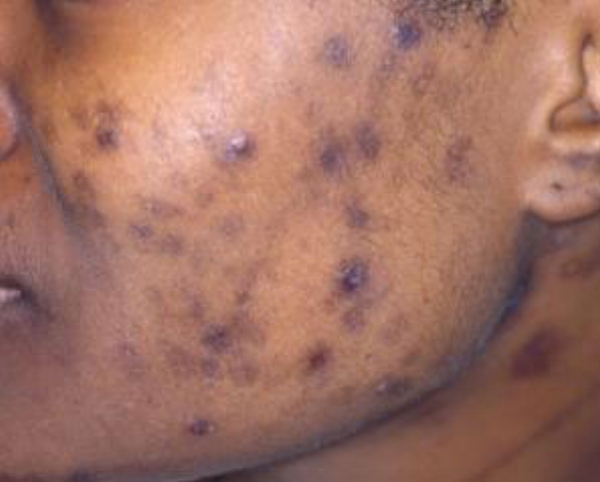I’m glad to hear that your acne has responded well to doxycycline. It is unfortunate that your battle with acne has caused persistent marks and scars. It must be difficult for you to deal with it. I hope my answer will be able to help you understand Q-switched Laser treatment of acne scars better.
When is Q-Switched Laser the best treatment for acne scars, and can it be combined with other treatments?
Q-switched Laser is the best treatment for acne scars when we want to treat:
1. Flat brown marks known as Post Inflammatory Hyperpigmentation (PIH)
2. Rolling scars when minimal downtime is desired, particularly in darker skin types, using a Fractional Picosecond Laser (such as Discovery Pico, Picosure, etc)

Post Inflammatory Hyperpigmentation (source)
Q-switching and PIH
Q-switching (quality switching) is a technique used to produce short laser pulses with high power. It is widely used in medical lasers. Such lasers may be of various wavelengths (such as 532/1064nm Nd:YAG, 694nm Ruby, 755nm Alexandrite) and pulse durations (nanosecond or the shorter picosecond).
The short Q-switched laser pulses confine the laser energy to small structures such as melanin-containing cells (melanosomes) and produce mostly photomechanical effects. This makes it ideal for treating PIH as most of the laser energy goes to breaking up the excess melanin without too much collateral damage.
I find that for my patients, lasers with higher absorption in melanin (such as Ruby Laser) or newer Picosecond Q-Switched lasers with shorter, more intense picosecond pulses produce better melanin disruption and thus give much faster results. I also prescribe topical medications that inhibit melanin formation to speed up the resolution of PIH. Sunblock with SPF at least 30-50 is essential.
Q-switching and Scarring
Q-switched Lasers in the form of Fractional Picosecond Lasers are great at treating shallow rolling scars
- ideal for busy patients as they generally do not require much downtime beyond mild temporary redness for about 1 day
- ideal for darker skinned patients that have higher risks of complications (such as PIH) with other scarring treatments such as Fractional Lasers
In Fractional Picosecond Laser treatments, high powered Q-switched laser pulses are delivered in a picosecond (trillionth of a second) via a special fractional hand-piece that further concentrates the laser energy into many small pin-point treatment zones.
Added together, these treatment zones constitute a fraction of the treated skin surface, hence the appellation ‘fractional’. This concentrated laser power is absorbed by structures in the skin, triggering Laser Induced Optical Breakdown (LIOB) and associated shockwaves.
The intense photomechanical stimulus triggers scar remodeling and collagen production. As melanin absorbs the laser energy and forms a focus for the subsequent plasma formation and cavitation, LIOBs are actually produced more efficiently in darker skin patients.
Fractional Microneedling Radiofrequency or Fractional Laser may produce more obvious results, but each treatment has its own strength and weaknesses. It’s imperative to evaluate the type and configuration of scarring, skin type and colour, as well as patient lifestyle and budget.
Lasers and other energy-based scar treatments can be combined with scarring treatments such as Subcision, Filler, TCA Cross, Rejuran, Skinboosters for better results. In fact, combination treatment usually yields better results as most patients have a combination of scar types.
Acne treatments such as hydradermabrasion, chemical peels, oral and topical medication can also be done concurrently. The type and sequence of combination treatment has to be individualized to each patient. I personally prefer to start with the more obvious scars first.
Do consult a doctor who can assess your scars in person, explain the pros and cons of each treatment and advise on the most suitable approach for your skin, scar type, and lifestyle, as even the best treatment available may not be the best treatment for YOU.
Hope this explanation makes things clearer for you!
Warmest regards,
Dr. Wan Chee Kwang
References
1. Cho SB et al. Treatment of post-inflammatory hyperpigmentation using 1064-nm Q-switched Nd:YAG laser with low fluence: report of three cases. J Eur Acad Dermatol Venereol. 2009;23:1206–1207.
2. Bernstein EF et al. Treatment of acne scarring with a novel fractionated, dual-wavelength, picosecond-domain laser incorporating a novel holographic beam-splitter. Lasers Surg Med. 2017 Nov;49(9):796-802.
3. Bhargava S et al.Acne Scarring Management: Systematic Review and Evaluation of the Evidence. Am J Clin Dermatol. 2018 Aug;19(4):459-477.
